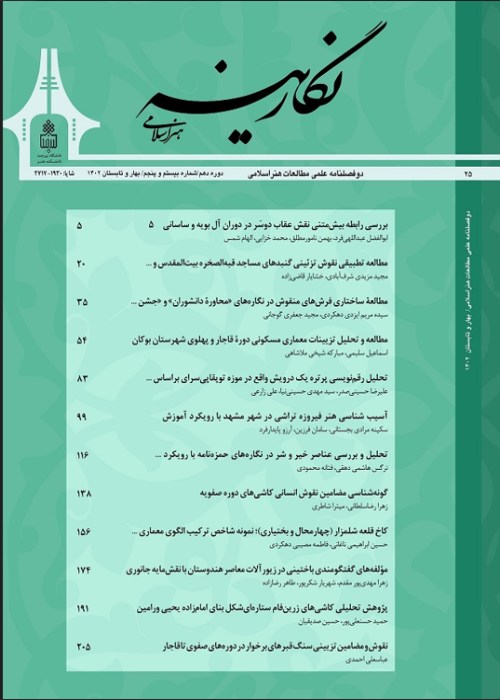Homogeneity analysis of decorative and architectural arrays in Safavid and Qajar buildings Case examples: Rokan-ol-Molk and Chaharbagh schools-mosques in Isfahan
Author(s):
Article Type:
Research/Original Article (دارای رتبه معتبر)
Abstract:
Religious buildings have a special place in the Iranian-Islamic architecture, in addition to the architectural structure in terms of arrays. Isfahan, as one of the historical cities of Iran, includes different types of religious buildings, especially in the Safavid and Qajar historical periods. The mosque-school of Chaharbagh and Rokn al-Molk have been studied as two significant examples of the Safavid and Qajar eras in the present study. It should be noted that the main goal of the present study, while briefly recognizing the structure and decoration, architecture of the mentioned buildings, is to focus on the study of the fit of the body of the building and their decorative arrays. The purpose is to answer the question that what are the most important decorative arts used in the two mosques-school, Chaharbagh and Rokn al-Molk, while explaining the points of difference and similarity? What are the main components of these arts in terms of visual structure, adaptation to architectural structure, as well as role and content? This research is comparative in terms of approach and descriptive-analytical in terms of method. Also, data collection has been done by documentary method and field observations and the information has been qualitatively analyzed. The findings of the present study indicate that the two quadrangular buildings studied in this study, while having similarities in the structural dimension, have significant differences in terms of building dimensions and performance quality. Arts with arts such as engraving, traditional goldsmithing, tapestry, gilding on plaster, etc. have significant differences with the building of Rokn al-Molk. But there is a remarkable fit between the architectural arrays and the architectural structure of each building. Also, in terms of motifs and content, both buildings have represented the artistic features of their time, so that in Chaharbagh building, we see the multiplicity of geometric motifs, Islamic and Khatai motifs and abstract motifs with cold colors such as azure and turquoise. There are more of us, and in front of the mosque-school, Rokan al-Mulk is full of naturalistic motifs, human roles and various and predominantly warm colors.
Language:
Persian
Published:
Journal of Negarineh Islamic Art, Volume:7 Issue: 19, 2021
Pages:
135 to 152
magiran.com/p2267898
دانلود و مطالعه متن این مقاله با یکی از روشهای زیر امکان پذیر است:
اشتراک شخصی
با عضویت و پرداخت آنلاین حق اشتراک یکساله به مبلغ 1,390,000ريال میتوانید 70 عنوان مطلب دانلود کنید!
اشتراک سازمانی
به کتابخانه دانشگاه یا محل کار خود پیشنهاد کنید تا اشتراک سازمانی این پایگاه را برای دسترسی نامحدود همه کاربران به متن مطالب تهیه نمایند!
توجه!
- حق عضویت دریافتی صرف حمایت از نشریات عضو و نگهداری، تکمیل و توسعه مگیران میشود.
- پرداخت حق اشتراک و دانلود مقالات اجازه بازنشر آن در سایر رسانههای چاپی و دیجیتال را به کاربر نمیدهد.
In order to view content subscription is required
Personal subscription
Subscribe magiran.com for 70 € euros via PayPal and download 70 articles during a year.
Organization subscription
Please contact us to subscribe your university or library for unlimited access!



